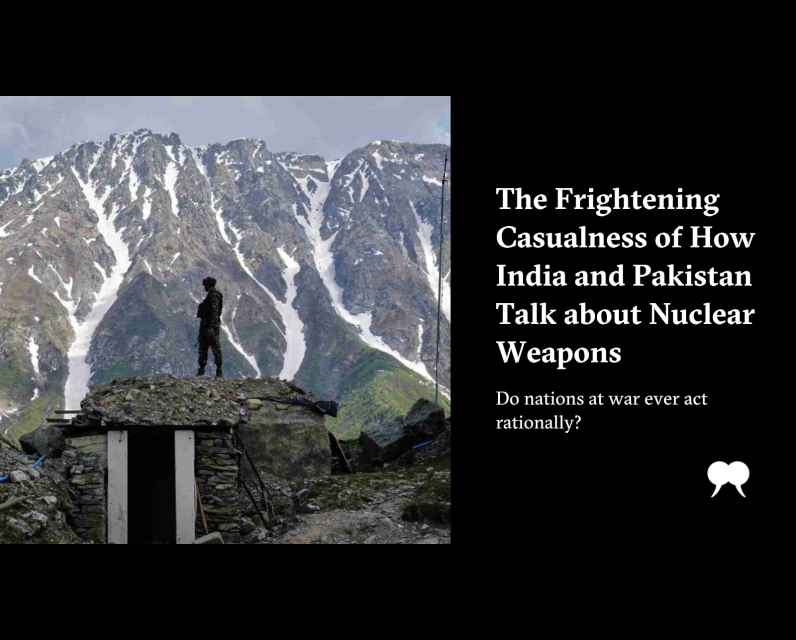Source Feed: Walrus
Author: C. Rammanohar Reddy
Publication Date: June 18, 2025 - 06:30
The Frightening Casualness of How India and Pakistan Talk about Nuclear Weapons
June 18, 2025

Are we now so casual about the dangers of nuclear weapons that we do not realize what we have escaped from with the decision by India and Pakistan to cease fire on May 10? The events that led to the intervention of the United States in South Asia remain murky, but what did happen for sure is that India and Pakistan were brought down from a nuclear-weapon escalatory ladder.
This is not the first time that the South Asian neighbours have come to the edge of a precipice. We will have to wait for historians and declassified records to give us a true picture of past events. But the diaries and accounts of US officials of the time tell us with some persuasion that the two countries have had to be pulled back after one or the other threatened to use these weapons of mass destruction at least thrice earlier: in 1990, 1999, and 2019.
May 2025 is the fourth such occasion where, at the very least, the nuclear sabres were rattled. A news report on May 10 announced that Pakistan had convened a meeting of its National Command Authority, the body taking decisions on matters nuclear. The report was predictably later denied; the sequence of events may have been a case of “signalling.” If so, this was a dangerous tactic for a nuclear power to play. The US intervened this time as well to prevent escalation, but the next time, neither the US nor any other mediator may be able to.
When India went openly nuclear in 1998 (quickly followed by Pakistan), we were told that with the power of deterrence, military conflict with conventional forces would end. It did not happen. We were also told that there would be red lines to conflict with conventional forces. That did not happen either. And of course, we were told that with both countries holding nuclear arsenals, neither would be emboldened to use these weapons against the other—that it would deter a nuclear attack. Mercifully, there has been no nuclear war, but we seem to have come close to it on more than one occasion.
Clear the fog around the theory of nuclear deterrence and we can see it very simply for what it is: blackmail. Attack me with nuclear weapons and I will use mine with such force that it will inflict unimaginable destruction on you. This blackmail that is contained in nuclear deterrence is supposed to work because the opposing party is expected to act rationally and not cross the threshold in the use of nuclear weapons. But do nations at war act rationally? In the fog of war, as it is called, the most irrational of decisions are taken on the spur of the moment. The alleged protection against nuclear escalation is based, then, on as flimsy an assumption as human rationality during a crisis.
The argument for nuclear weapons is that they offer protection against existential threats, but some countries have much lower thresholds. For instance, in 2001, a senior army adviser to Pakistan on its nuclear policy drew red lines that included even economic sanctions and destruction of key military assets.
As Indian political scientist and peace activist Achin Vanaik has pointed out, India and Pakistan have fought as many as four conventional wars in the past seventy-eight years—in 1948, 1965, 1971, and 1999—and the history of frequent conflict adds an additional dimension of risk to the possession of nuclear weapons. It does not help that the two countries have not exhibited great maturity in talking about these weapons. If one country has spoken of the use of tactical nuclear weapons, the other has asked “if nuclear weapons are meant to be used only for Diwali.”
In the week since the ceasefire, governments, the media, and political outfits have continued to speak casually about nuclear weapons and new and old doctrines. This talk is seeping into wider public discourse. We would be horrified if we could only step back and see the implications of our conversations.
To rephrase a well-known phrase, there is a frightening banality to the casualness with which the governments and societies of the two countries now speak about nuclear weapons. These are weapons that can cause civilizational damage. That they have not been used in the past eighty years since Hiroshima and Nagasaki is no guarantee that they will not be used again.
We know that at the height of the Cold War, the US and the Soviet Union, on more than one occasion, escaped causing a global Armageddon by the skin of their teeth, the most well-known instance of course being the 1962 Cuban Missile Crisis. All it will take is one miscalculation for things to go monumentally wrong. This is something that not just the US, Russia, China, the United Kingdom, France, Israel, and North Korea (the latter two being unstated nuclear powers) must remember.
The scope for provocation is increasing in South Asia with each round of conflict. More sophisticated and more powerful weapons are being used (compare 2025 with 2019). This takes us up the escalation ladder, and in the heat of war, a disastrous miscalculation can well take place.
Added to the military complexity is the emergence of warmongers on TV screens and social media who are neither aware of the dangers of warfare nor care for the human costs of war. Yet they are driving public discourse, especially in India. In both countries, religious chauvinism is influencing national policy. It is now no longer a case of riding a tiger that the ruling political parties cannot get off. The culture of the past decade has been to look away from, if not to actively encourage, hate and hysteria. This has hatched an army of citizens that is consuming society with its poison.
At the height of the Cold War, a TV film, The Day After, presented a fictional portrayal of the aftermath of a nuclear war as experienced by two cities in the US Midwest. The film unnerved the viewing public. Then president Ronald Reagan wrote in his diary that it left him “greatly depressed” and that it changed his views on nuclear war. He later wrote that the signing of the 1987 nuclear weapons agreement with the Soviet Union could be traced back to the impact of the film. A right-wing president who laid store by militarization changed his mind after realizing the horrors of a nuclear confrontation.
Can we hope for a similar change in attitudes about nuclear weapons in India and Pakistan after they came close to a nuclear confrontation yet again? We must wake up and realize what we are sitting on. One escalatory event after the other could lead to the use of nuclear weapons, and one use will cause a catastrophe that can never be reversed.
This piece was originally published as “India, Pakistan and The Day After” by The Wire. It has been republished here with permission.The post The Frightening Casualness of How India and Pakistan Talk about Nuclear Weapons first appeared on The Walrus.
The case against Husam Taha Ali Al-Sewaiee was dropped after police received new information.
July 17, 2025 - 16:52 | Stewart Bell | Global News - Canada
A young Indian man, denied refugee status in Canada because his story of being framed for his friend’s murder was “strikingly similar” to five people who travelled here with him and nearly 200 others who employed the same immigration consultant, has won another chance at staying in Canada.
Parwinder Singh took the decision from Canada’s Refugee Appeal Division (RAD) to a federal court judge for review. The judge granted the review and sent Singh’s case back to another decision-maker at the division for re-evaluation.
“Although narrative similarities between claimants may reasonably...
July 17, 2025 - 16:49 | Chris Lambie | National Post
Oil and gas drillers that import vast amounts of sand such as silica and quartz from the U.S. are getting relief from counter-tariffs that could have added heavy costs to industry.
July 17, 2025 - 16:40 | Globalnews Digital | Global News - Canada




Comments
Be the first to comment